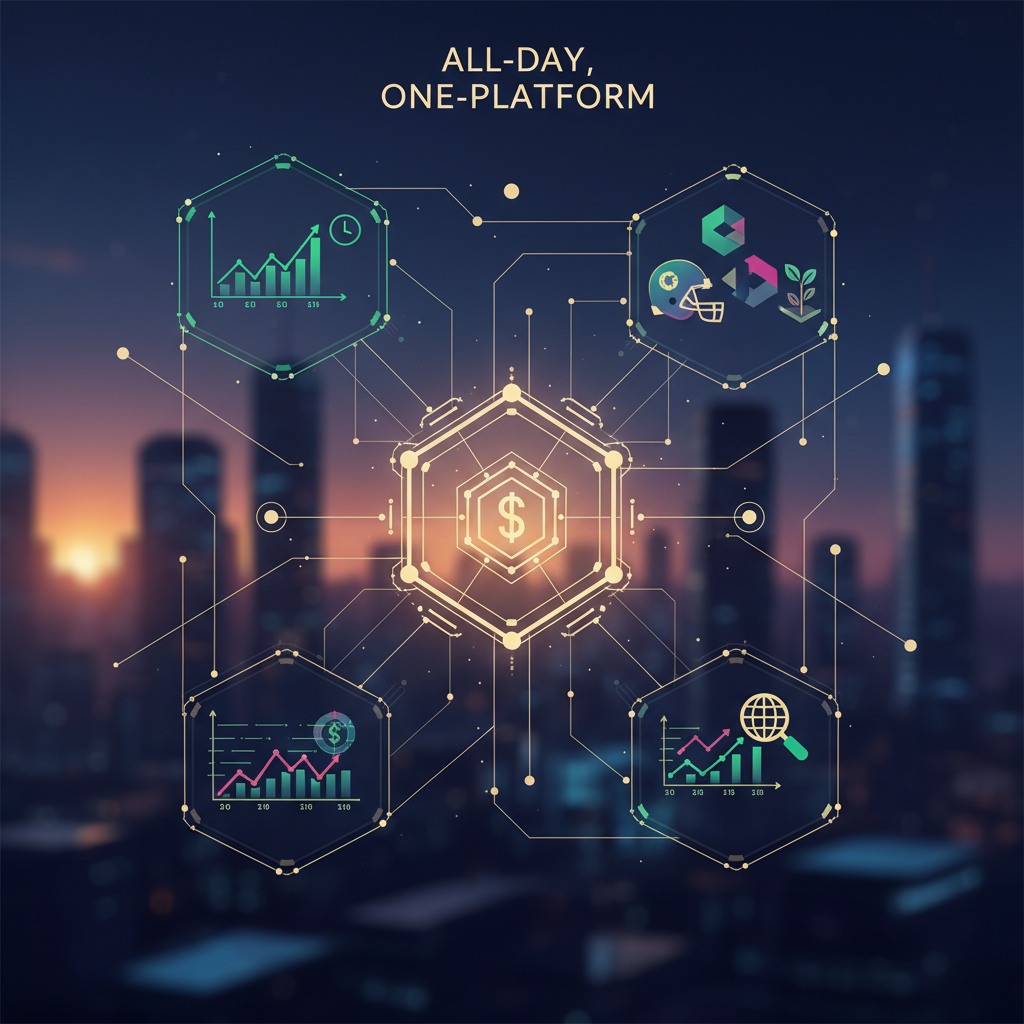Educational content. NOT Financial Advice. See Use of AI Disclosure and Terms and Conditions of Use
Why Robinhood’s Prediction Markets and Crypto Expansion Isn’t Just Product Growth – It’s Platform Transformation
Imagine a world where your brokerage app lets you trade stocks at 5am, bet on the Super Bowl at noon, stake crypto by dinner, and speculate on tomorrow’s economic data before bed – all from one platform with zero friction. That world arrived this year, and most investors are completely missing what Robinhood is building. While traditional analysts obsess over quarterly metrics and regulatory headlines, they’re overlooking a profound transformation: Robinhood is evolving from a simple trading app into something far more powerful – a global financial superapp that captures exponentially more engagement, more deposits, and more of your financial life.
The numbers tell an acceleration story that should excite any growth investor. According to public market data (October 11, 2025), HOOD trades at $138.96 with a market cap of $123.5 billion – and revenue growth is nothing short of explosive. According to SEC quarterly filings (Q2 2025), the company delivered $989 million in revenue with a stunning 92% gross margin, representing 55% quarter-over-quarter growth. This isn’t a struggling fintech trying to survive – this is a company hitting escape velocity.
The Prediction Markets Revolution: 25 Million Users Meet Event Trading
Here’s where it gets transformative. According to Robinhood’s Official Newsroom (March 2025), the company launched a Prediction Markets Hub through its partnership with CFTC-regulated Kalshi, instantly bringing event trading to 25 million users across the United States. Think about that total addressable market expansion for a moment. Robinhood isn’t just adding a feature – they’re democratizing an entirely new asset class.

Why Robinhood’s Prediction Markets and Crypto Expansion Isn’t Just Product Growth – It’s Platform Transformation
According to The Defiant (August 19, 2025), the partnership expanded to include NFL and NCAA football prediction markets, letting users speculate on the outcomes of America’s most popular sport. But the vision extends far beyond sports. According to Gaming Intelligence (March 18, 2025), these contracts cover elections, economic data releases, and geopolitical developments – turning news events into tradable markets with the rigor and transparency of financial market structure.
The international opportunity might be even bigger. According to CoinDesk (September 30, 2024), Robinhood has begun discussions with overseas regulators including the UK’s Financial Conduct Authority to explore how localized versions could be structured in the UK and Europe. This isn’t a U.S.-only product launch – it’s the opening salvo in a global platform expansion.
The Bitstamp Acquisition: 50 Licenses, Institutional Scale, Global Reach
While prediction markets capture headlines, the $200 million Bitstamp acquisition might be the more strategic masterstroke. According to Bitstamp’s Official Blog (June 6, 2024), the deal – which closed in June 2025 according to The Block (June 3, 2025) – brings over 50 active global licenses and registrations, dramatically accelerating Robinhood Crypto’s worldwide expansion across the EU, UK, US, and Asia.
This is where the institutional story emerges. According to Cointelegraph (June 2, 2025), Bitstamp serves over 5,000 institutional clients with established infrastructure for lending, staking, and “crypto as a service” – capabilities Robinhood’s retail-focused platform lacked. The acquisition brings 14 years of institutional trust, deep liquidity, and regulatory credibility in markets where Robinhood had limited presence.
According to Fortune (June 6, 2024), Bitstamp offers up to 85 digital tokens in some markets compared to Robinhood’s dozen or so, plus lending and staking services that open new revenue streams. For context, according to CNBC (June 2, 2025), Bitstamp generated $95 million in revenue for the 12 months ending April 30, while Robinhood’s crypto business alone made $252 million in Q1 2025. The combined entity creates a crypto powerhouse with retail scale and institutional depth.
The Platform Flywheel: Why These Moves Compound
Here’s what Wall Street is missing: these aren’t isolated product launches. They’re interconnected pieces of a superapp strategy that creates a powerful engagement flywheel. A user who comes for stock trading stays for prediction markets. A crypto trader who needs institutional services finds them on the same platform. International users who want U.S. equities access Robinhood through its global licenses. Each product expansion makes the platform stickier, drives more deposits, and increases lifetime value.
The financial performance validates this thesis. According to SEC quarterly data analyzed through Q2 2025, operating margins expanded from negative 15.6% in Q3 2023 to a powerful 44.5% in Q2 2025, while revenue accelerated from $467 million to $989 million – more than doubling in under two years. This is what successful platform transformation looks like: rapid revenue growth with improving unit economics.
According to TipRanks (October 2025), analysts maintain a consensus “Moderate Buy” rating with 31 Buy ratings versus just 1 Sell rating, and Deutsche Bank recently raised its price target to $140 while maintaining a Buy rating. According to Benzinga (October 2025), B of A Securities raised their price target range to $157 from $139 while maintaining their Buy rating.
Investment Summary: The Superapp Transformation is Just Beginning
Robinhood’s product expansion isn’t incremental feature development – it’s a fundamental platform transformation that multiplies the addressable market. Prediction markets bring event trading to 25 million users with global expansion planned. The Bitstamp acquisition delivers 50+ international licenses, 85+ crypto tokens, institutional infrastructure, and access to high-growth markets across Europe and Asia. Combined, these moves transform Robinhood from a U.S.-centric retail trading app into a global financial superapp with multiple engagement vectors and revenue streams.
The skeptics will point to regulatory risk, competitive pressure, and execution challenges. They’re not wrong – but they’re missing the forest for the trees. The same concerns existed when Robinhood democratized commission-free trading, when they launched crypto trading, when they built a cash management product. Each time, the platform expanded, users multiplied, and the business model strengthened.
For growth investors who understand platform economics and network effects, Robinhood’s current transformation represents exactly the kind of opportunity we live for: a company with proven execution capability, massive user base, strong financial momentum, and multiple vectors for exponential expansion. While others worry about the near-term volatility, visionary investors should recognize what’s being built – a global financial operating system for the next generation. The best time to own transformative platforms isn’t after they’ve fully realized their potential – it’s during the construction phase, when the pieces are just starting to come together.
That construction phase is happening right now.
Grace
Grace is an analyst specializing in disruptive growth investing and transformative technology opportunities. Inspired by visionary investors like Cathie Wood, Grace identifies companies positioned to benefit from revolutionary innovations and exponential trends.Disclaimer
Analysis on this site is generated in whole or in part by our proprietary AI tools for informational purposes only and should not be considered investment advice. AI-generated content may contain errors and may not have been reviewed by human analysts. The publisher may hold positions in securities discussed on this site and reserves the right to buy or sell such positions at any time without notice. Past performance does not guarantee future results. Investments involve risk of loss. Consult financial professionals before investing. See Use of AI Disclosure and Terms and Conditions of Use



